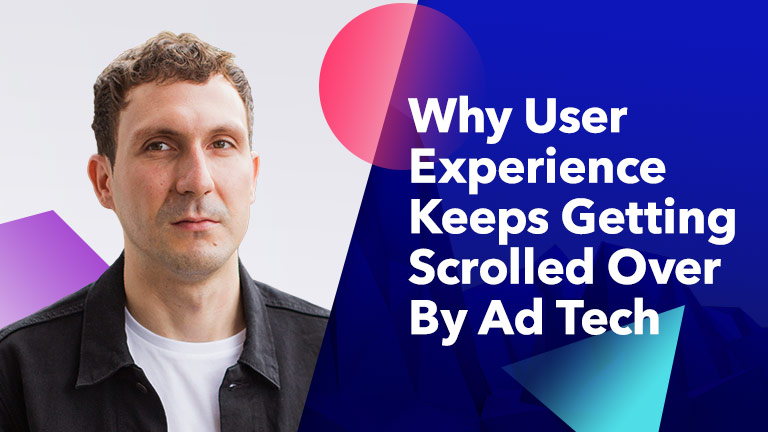The research report by The Coalition for Better Ads raised a lot of dust and inconvenient questions. Especially when rumours were confirmed that Google is implementing ad-blocker ad-filter into Chrome based on the research findings.
Particularly interesting is the case of Fullscreen ScrollOver Ads which joined the usual suspects on the list of least preferred formats. Even though the category officially refers to a specific type of scroll-based ads, many were confused about the discrepancy with results published by IAB in a preceding study of a similar format called Scroller.
To most people, the difference between both formats might seem nothing more than a superficial stylistic choice. One is presented and dismissed by covering the content, the other is covered by the content to be presented and dismissed. That is, until you encounter them first hand…
ScrollOver hijacks the scrolling mechanism to be displayed. This results in the user suddenly losing control over the interaction as the page stops responding to the gesture. The unexpected occurrence is likely to cause confusion and interrupt the user's focus in the middle of reading. When finally in view, the ad covers the majority of content and physically prevents reading. After dismissing the ad, the user is forced to find the position where she left off.
Scroller, on the other hand is revealed as a consequence of reading. Despite noticing the ad gradually coming into view with peripheral vision, the user is able to maintain focus on reading and control the interaction at all times. The ad claims full attention only after the preceding content has been read, while scrolling past it immediately brings into view consecutive lines of text.
Perhaps polarising consumer attitudes about the formats in question have to do with their properties which either support or obstruct consumption of content.
However to just trash talk ScrollOver would be missing the point. When you consider that its price is based on the duration in view, it becomes apparent that the genius of its design lies in serving business objectives, not user needs.
Which brings us to a larger and far more important question. How did one of the most profitable and creative industries become the benchmark for poor, if not malicious design? Were advertisers in Cannes when the rest of the tech class was taking lessons on user-centered design methodology?
The fact of the matter is, the design of ad products does cater to the user. It's just that we're operating in an industry where the user is not the same person as the customer. Those who pay for ad products do so for others to use them. Hence, it's the nature of the business that forces design of the ad formats to prioritise interests of transacting parties over those of the audience — often to hide, remedy or obfuscate poor quality of ad inventory. The question we have yet to answer is whether this approach pays off in the long run.
For over a year now the ad industry has been chanting the mantra of improving user experience to countermeasure ad-blocking. Yet creatives are still being churned through annoying and obtrusive formats. Where TV experimented with duration and placement for decades to bridge conflicting interests, digital simply standardised sizes and moved on. Now we find ourselves stuck with standards and technological infrastructure that make it virtually impossible to create better ad formats — at least not the kinds that would work in the mobile browser, in-app, cross-screen, and be sold on the open exchange market.
As a result, media budgets are drastically shifting to video where the creative canvas is more accommodating and the overall experience more pleasant. But video is not the solution for all our display problems.
For a change of perspective, one can turn around to see what the long tail is doing. Currently those with small budgets and no padding for ineffectiveness are mastering the game on social media. Their ads are given the same format as content, so they are able to properly tell their story, but imposed with creative restrictions that prevent user experience offences. Who would have thought that crafting ads with a clear context in mind and presenting them in a suitable format would improve performance?
This is the point where I would usually be called naive and my argument dismissed as uneconomic. Supposedly publishers, especially small ones, cannot afford to enforce creative restrictions or deviate from standard formats, because agencies would rather exclude them from media plans than deal with any more inconvenience due to fragmentation.
Finally there are proofs debunking this myth. After their first year anniversary, Joshua Topolsky reported that The Outline was able to achieve 13x industry average interaction rate and 25x clickthrough rate by developing custom ad formats and a platform “that has more in common with Snapchat or Instagram than anything resembling “web advertising” (aka pop-up hell)”. Can you imagine the CPM on those bad boys? Their operation might not be comparable with those of publisher giants, networks and SSPs but that is precisely the point. Quality content and advertising are not created with mindless one-size-fits-all copy-pasting techniques.
Like it or not, cleaning this media mess will require putting money where our mouths are. That is, making ad products that satisfy the audience's interests first. May the user-centered design school dropouts be reminded of the premise, that satisfying interests of the user those who use the product, is bound to consequentially satisfy interests of other stakeholders.
Hustling the user is hard work. Inventing new ways to do it again and again is exhausting. Thus far, providing real value and playing nice has consistently turned out to be a more sustainable business strategy. Ask Ryanair.
 | Natan Nikolic |

